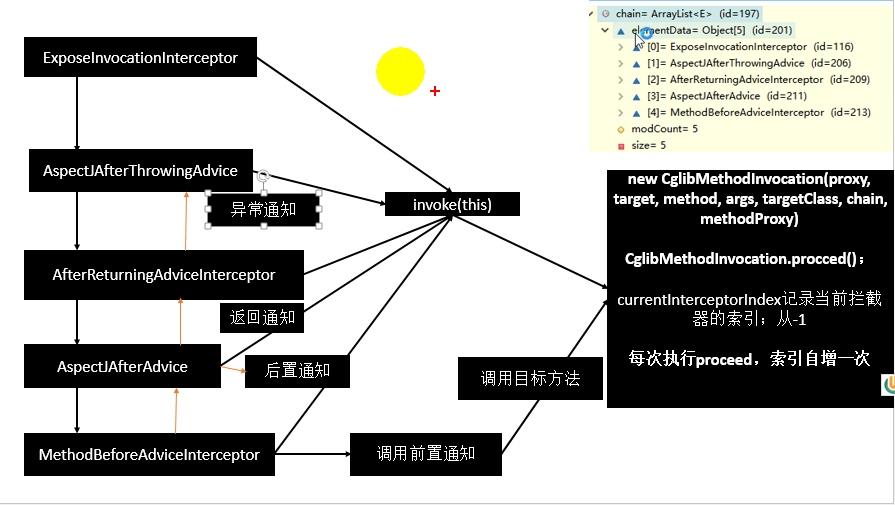spring5 源碼深度解析—– AOP目標方法和增強方法的執行(100%理解AOP)
- 2019 年 10 月 11 日
- 筆記
上一篇博文中我們講了代理類的生成,這一篇主要講解剩下的部分,當代理類調用時,目標方法和代理方法是如何執行的,我們還是接著上篇的ReflectiveMethodInvocation類Proceed方法來看
public Object proceed() throws Throwable { // 首先,判斷是不是所有的interceptor(也可以想像成advisor)都被執行完了。 // 判斷的方法是看currentInterceptorIndex這個變數的值,增加到Interceptor總個數這個數值沒有, // 如果到了,就執行被代理方法(invokeJoinpoint());如果沒到,就繼續執行Interceptor。 if (this.currentInterceptorIndex == this.interceptorsAndDynamicMethodMatchers.size() - 1) { return invokeJoinpoint(); } // 如果Interceptor沒有被全部執行完,就取出要執行的Interceptor,並執行。 // currentInterceptorIndex先自增 Object interceptorOrInterceptionAdvice = this.interceptorsAndDynamicMethodMatchers.get(++this.currentInterceptorIndex); // 如果Interceptor是PointCut類型 if (interceptorOrInterceptionAdvice instanceof InterceptorAndDynamicMethodMatcher) { InterceptorAndDynamicMethodMatcher dm = (InterceptorAndDynamicMethodMatcher) interceptorOrInterceptionAdvice; // 如果當前方法符合Interceptor的PointCut限制,就執行Interceptor if (dm.methodMatcher.matches(this.method, this.targetClass, this.arguments)) { // 這裡將this當變數傳進去,這是非常重要的一點 return dm.interceptor.invoke(this); } // 如果不符合,就跳過當前Interceptor,執行下一個Interceptor else { return proceed(); } } // 如果Interceptor不是PointCut類型,就直接執行Interceptor裡面的增強。 else { return ((MethodInterceptor) interceptorOrInterceptionAdvice).invoke(this); } }
我們先來看一張方法調用順序圖

我們看到鏈中的順序是AspectJAfterThrowingAdvice、AfterReturningAdviceInterceptor、AspectJAfterAdvice、MethodBeforeAdviceInterceptor,這些攔截器是按順序執行的,那我們來看看第一個攔截器AspectJAfterThrowingAdvice中的invoke方法
AspectJAfterThrowingAdvice
1 @Override 2 public Object invoke(MethodInvocation mi) throws Throwable { 3 try { 4 //直接調用MethodInvocation的proceed方法 5 //從proceed()方法中我們知道dm.interceptor.invoke(this)傳過來的參數就是ReflectiveMethodInvocation執行器本身 6 //這裡又直接調用了ReflectiveMethodInvocation的proceed()方法 7 return mi.proceed(); 8 } 9 catch (Throwable ex) { 10 if (shouldInvokeOnThrowing(ex)) { 11 invokeAdviceMethod(getJoinPointMatch(), null, ex); 12 } 13 throw ex; 14 } 15 }
第一個攔截器AspectJAfterThrowingAdvice的invoke方法中,直接調用mi.proceed();,從proceed()方法中我們知道dm.interceptor.invoke(this)傳過來的參數就是ReflectiveMethodInvocation執行器本身,所以又會執行proceed()方法,攔截器下標currentInterceptorIndex自增,獲取下一個攔截器AfterReturningAdviceInterceptor,並調用攔截器中的invoke方法,,此時第一個攔截器在invoke()方法的第七行卡住了,接下來我們看第二個攔截器的執行
AfterReturningAdviceInterceptor
1 @Override 2 public Object invoke(MethodInvocation mi) throws Throwable { 3 //直接調用MethodInvocation的proceed方法 4 Object retVal = mi.proceed(); 5 this.advice.afterReturning(retVal, mi.getMethod(), mi.getArguments(), mi.getThis()); 6 return retVal; 7 }
AfterReturningAdviceInterceptor還是直接調用mi.proceed(),又回到了ReflectiveMethodInvocation的proceed()方法中,此時AfterReturningAdviceInterceptor方法卡在第四行,接著回到ReflectiveMethodInvocation的proceed()方法中,攔截器下標currentInterceptorIndex自增,獲取下一個攔截器AspectJAfterAdvice,並調用AspectJAfterAdvice中的invoke方法
AspectJAfterAdvice
1 @Override 2 public Object invoke(MethodInvocation mi) throws Throwable { 3 try { 4 //直接調用MethodInvocation的proceed方法 5 return mi.proceed(); 6 } 7 finally { 8 invokeAdviceMethod(getJoinPointMatch(), null, null); 9 } 10 }
AspectJAfterAdvice還是直接調用mi.proceed(),又回到了ReflectiveMethodInvocation的proceed()方法中,此時AspectJAfterAdvice方法卡在第五行,接著回到ReflectiveMethodInvocation的proceed()方法中,攔截器下標currentInterceptorIndex自增,獲取下一個攔截器MethodBeforeAdviceInterceptor,並調用MethodBeforeAdviceInterceptor中的invoke方法
MethodBeforeAdviceInterceptor
1 @Override 2 public Object invoke(MethodInvocation mi) throws Throwable { 3 //終於開始做事了,調用增強器的before方法,明顯是通過反射的方式調用 4 //到這裡增強方法before的業務邏輯執行 5 this.advice.before(mi.getMethod(), mi.getArguments(), mi.getThis()); 6 //又調用了調用MethodInvocation的proceed方法 7 return mi.proceed(); 8 }
第5行程式碼終於通過反射調用了切面裡面的before方法,接著又調用mi.proceed(),我們知道這是最後一個攔截器了,此時this.currentInterceptorIndex == this.interceptorsAndDynamicMethodMatchers.size() – 1應該為true了,那麼就會執行 return invokeJoinpoint();,也就是執行bean中的目標方法,接著我們來看看目標方法的執行
@Nullable protected Object invokeJoinpoint() throws Throwable { return AopUtils.invokeJoinpointUsingReflection(this.target, this.method, this.arguments); } @Nullable public static Object invokeJoinpointUsingReflection(@Nullable Object target, Method method, Object[] args) throws Throwable { // Use reflection to invoke the method. try { ReflectionUtils.makeAccessible(method); //直接通過反射調用目標bean中的method return method.invoke(target, args); } catch (InvocationTargetException ex) { // Invoked method threw a checked exception. // We must rethrow it. The client won't see the interceptor. throw ex.getTargetException(); } catch (IllegalArgumentException ex) { throw new AopInvocationException("AOP configuration seems to be invalid: tried calling method [" + method + "] on target [" + target + "]", ex); } catch (IllegalAccessException ex) { throw new AopInvocationException("Could not access method [" + method + "]", ex); } }
before方法執行完後,就通過反射的方式執行目標bean中的method,並且返回結果,接下來我們想想程式該怎麼執行呢?
1 、MethodBeforeAdviceInterceptor執行完了後,開始退棧,AspectJAfterAdvice中invoke卡在第5行的程式碼繼續往下執行, 我們看到在AspectJAfterAdvice的invoke方法中的finally中第8行有這樣一句話 invokeAdviceMethod(getJoinPointMatch(), null, null);,就是通過反射調用AfterAdvice的方法,意思是切面類中的 @After方法不管怎樣都會執行,因為在finally中
2、AspectJAfterAdvice中invoke方法發執行完後,也開始退棧,接著就到了AfterReturningAdviceInterceptor的invoke方法的第4行開始恢復,但是此時如果目標bean和前面增強器中出現了異常,此時AfterReturningAdviceInterceptor中第5行程式碼就不會執行了,直接退棧;如果沒有出現異常,則執行第5行,也就是通過反射執行切面類中@AfterReturning註解的方法,然後退棧
3、AfterReturningAdviceInterceptor退棧後,就到了AspectJAfterThrowingAdvice攔截器,此攔截器中invoke方法的第7行開始恢復,我們看到在 catch (Throwable ex) { 程式碼中,也就是第11行 invokeAdviceMethod(getJoinPointMatch(), null, ex);,如果目標bean的method或者前面的增強方法中出現了異常,則會被這裡的catch捕獲,也是通過反射的方式執行@AfterThrowing註解的方法,然後退棧
總結
這個代理類調用過程,我們可以看到是一個遞歸的調用過程,通過ReflectiveMethodInvocation類中Proceed方法遞歸調用,順序執行攔截器鏈中AspectJAfterThrowingAdvice、AfterReturningAdviceInterceptor、AspectJAfterAdvice、MethodBeforeAdviceInterceptor這幾個攔截器,在攔截器中反射調用增強方法
